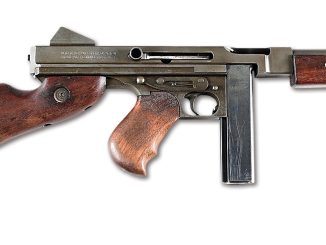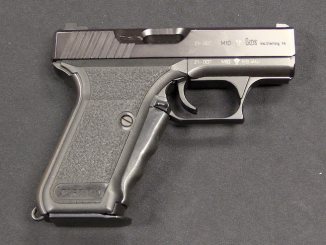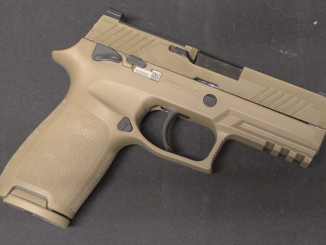With the advent of the tank in World War One, antitank rifles became a priority for many countries, to provide infantry with some weapon to counter the new armored threat. The best known example of these (and the only one to see significant production before the end of WWI) was the German Tankgewehr, any captured Tankgewehrs would form the basis for the US development of the .50 BMG cartridge.
This experimental Winchester rifle, made in late 1918, was part of that development. It is the only known surviving example of its type, and suffered a catastrophic failure during testing, as the receiver is cracked completely in half. The mechanism, however, is quite interesting. It uses a 1911-styled pistol grip as the bolt handle (similar to the Czech SS41 antitank rifle that would come decades later). It was fitted with a relatively large detachable box magazine and a mounting point for a telescopic sight.
Thanks to the Cody Firearms Museum for allowing me access to film it!




Great ideas can sometimes be too far ahead of their time. The problem here is getting a strong enough receiver without making the package too heavy to man handle.
It is possible that the weakness of the receiver could have been fixed by using a stronger (an more expensive, naturally) steel alloy.
“any captured Tankgewehrs would form the basis for the US development of the .50 BMG cartridge.”
Interestingly British .50 cartridge – .50 Vickers – was developed from .600 Nitro Express, initially it was simply .600 Nitro Express necked down to .500, later it evolved into belted cartridge and finally into rimless, see 1st from top here: https://sites.google.com/site/britmilammo/-5-inch-vickers
For British, its main purpose was anti-aircraft defense, especially heavy bombers (see Riesenflugzeug). It was intended for enlarged Vickers machine gun and Lewis machine gun. In twist of history, this cartridge was not used by British aviation, but their adversaries in World War II – namely Italy(Breda-SAFAT) and Japan (Ho-103); if I am not mistaken in fact Great Britain do not get .50″ or similar machine gun for own aviation, which early part of World War II forced them to use multiple rifle-caliber machine guns – for example Hurricane Mk I carried eight .303 machine guns when Hurricane Mk IIB – 12 machine guns of that caliber; though .50 Vickers cartridge was not used by British aviation, it was used by other British forces – as tank machine gun (see Light Tank Mk. VI) and AA machine gun in Royal Navy service.
.600/.500 inch cartridge was used in prototype of anti-tank rifle, namely Godsal in 1918: https://sites.google.com/site/britmilammo/-55-inch-boys-2
It should be used that Germany need for anti-tank rifle was more urgent that British, as French and British forces commonly used tanks, when German did it on much smaller scale.
Nearly all of the German tanks in WW1 were in fact captured and repaired British and French tanks. Only 20 German A7V tanks were manufactured and they had only two confirmed combat uses.
The A7Vs were used until the armistice in several engagements, to name a few. They left a lot to be desired and reports indicate German Tankers preferred using captured tanks.
“In March of 1918, four A7Vs were used during the Ludendorff Offensive spanning from March 21st, to July 18th.”
“The A7Vs were used in the post-artillery barrage period that preceded movement into enemy terrain and fought against the British defenses stationed at St. Quentin.”
“The recorded first-ever tank-versus-tank duel occurred southwest of Villers-Bretonneaux on April 27th, 1918. The Germans had captured the town and were aiming towards Amiens to enact a breakthrough in the Allied lines. German A7Vs were eventually sent to counter the Allied gains.”
“A7Vs were further used in anger at the Third Battle of the Aisne (May-June 1918)”
“At the Second Battle of the Marne (July 1918).”
“Their final actions were on October 11th, 1918 near the northern French town of Iwuy.”
Back in the 1960’s I used to go to the Winchester factory for what was described as the largest indoor rifle match in the world. While waiting for scores, we used to visit the factory collection, now at the museum in Cody. It’s going to take Ian a long time to do videos on all of it. Fantastic collection.
I have seen part of depositaries when factory was still operating. There is/was lots to Winchester!
About 2,000 competitors used to shoot in that match, over 3 days. There were many underground ranges there, used for testing and proof firing the rest of the year. Upstairs was the cafeteria and bowling alley.
Old good days…
I was there couple of years before they shot down. Management tried every trick to entice employees (machinist union) to cooperate. Over employee entrance was slogan: “Thru this door are walking some of the best craftsmen in the world”. Soon after came the final stab.
As an epitaph and keep sake I have got my 12ga Winchester pump gun.
With that stock and recoil spring, it has a “Buck Rogers” vibe.
Zap!!
I’ve been to Cody and the museum twice; if it was a little closer to home I’d go monthly, probably. An amazing place with a dizzying amount of firearms on view, and, obviously, in storage. If you’re going to Yellowstone for a vacation, do yourself a favor and plan a full day here and in Cody, it’s a great town (especially if you get there on the 4th of July weekend for the rodeo, too).
I thought this beast looked familiar, although prior to this I’d never even known it existed.
Then looking through my latest-purchased “gun book” (Small Arms Visual Encyclopedia by Martin J. Dougherty, Amber Books, 2017 ed.), I found these critters;
Gepard Anti-Materiel Rifle Family
https://en.wikipedia.org/wiki/Gep%C3%A1rd_anti-materiel_rifle
The Gepard M1 is almost a perfect “clone” of the Winchester M1918, complete to the “recoil system”. The only major difference is that it’s a single-shot and the bolt must be removed to reload each time.
Later versions were semiautomatic but retained the same basic configuration.
Was somebody perusing Winchester’s patent backfiles?
cheers
eon
Is it only me or is there a remarkable resemblance with the Hungarian “Gepard” Anti-materiel rifle?
Is there technical information anywhere regarding the weight, barrel length, and/or overall length of this rifle?